
Concept explainers
(a)
Interpretation:
The R or S configuration of the chiral center in the given molecule is to be designated.
Concept introduction:
When assigning priorities to substituents, the atom having the greater
When the fourth priority substituent is pointing away (it is attached by a dash bond) and the first, second, and third priority substituents are arranged clockwise, the configuration is R.
When the fourth priority substituent is pointing away (it is attached by a dash bond) and the first, second, and third priority substituents are arranged counterclockwise, the configuration is S.
If the fourth priority substituent is attached by a wedge bond, then the clockwise or counterclockwise arrangement of the first, second, and third priority substituents is determined, and that arrangement is reversed before assigning R or S.
Answer to Problem C.10P
The configuration of the chiral carbon atom in the given molecule is designated as S.
Explanation of Solution
The given molecule is

The IUPAC name for the above molecule, without considering the stereochemistry, would be
There is one chiral center in this molecule, and the substituents attached to it are
In the structure, the

The second and third position priorities are decided by the set of atoms one bond away from the respective points of attachment. The set for the ethyl substituent, which is located on the right, is
The configuration at the chiral center of the molecule is designated as above.
(b)
Interpretation:
The R or S configuration of the chiral center in the given molecule is to be designated.
Concept introduction:
When assigning priorities to substituents, the atom having the greater atomic number has the higher priority. In case of comparison between isotopes, the one having the greater atomic mass gets the higher priority. Substituents with double/triple bonds are treated differently from the substituents having only single bonds. An atom that is doubly bonded to another atom is treated as having two single bonds to the atom – one real (shown in black) and one imaginary (shown in red). An atom that is triply bonded to another atom is treated as having three single bonds to the atom – one real (shown in black) and two imaginary (shown in red).
When the fourth priority substituent is pointing away (it is attached by a dash bond) and the first, second, and third priority substituents are arranged clockwise, the configuration is R.
When the fourth priority substituent is pointing away (it is attached by a dash bond) and the first, second, and third priority substituents are arranged counterclockwise, the configuration is S.
If the fourth priority substituent is attached by a wedge bond, then the clockwise or counterclockwise arrangement of the first, second, and third priority substituents is determined, and that arrangement is reversed before assigning R or S.
If the fourth priority substituent is in the plane of the page, then it is switched with the substituent that points away. Then the clockwise or counterclockwise arrangement of the first, second, and third priority substituents is determined, and that arrangement is reversed before assigning R or S.
Answer to Problem C.10P
The configuration of the chiral carbon atom in the given molecule is designated as R.
Explanation of Solution
The given molecule is
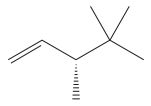
The IUPAC name for the above molecule, without considering the stereochemistry, would be
There is one chiral center in this molecule, and the substituents attached to it are
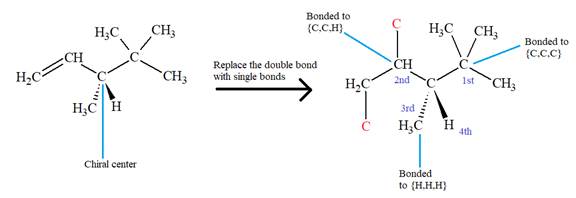
The first three top-priority substituents are decided by the set of atoms one bond away from the respective points of attachment. The set for the substituent, which is located on the right, is
The configuration at the chiral center of the molecule is designated as above.
(c)
Interpretation:
The R or S configuration of the chiral center in the given molecule is to be designated.
Concept introduction:
When assigning priorities to substituents, the atom having the greater atomic number has the higher priority. In case of comparison between isotopes, the one having the greater atomic mass gets the higher priority. Substituents with double/triple bonds are treated differently from the substituents having only single bonds. An atom that is doubly bonded to another atom is treated as having two single bonds to the atom – one real (shown in black) and one imaginary (shown in red). An atom that is triply bonded to another atom is treated as having three single bonds to the atom – one real (shown in black) and two imaginary (shown in red).
When the fourth priority substituent is pointing away (it is attached by a dash bond) and the first, second, and third priority substituents are arranged clockwise, the configuration is R.
When the fourth priority substituent is pointing away (it is attached by a dash bond) and the first, second, and third priority substituents are arranged counterclockwise, the configuration is S.
If the fourth priority substituent is attached by a wedge bond, then the clockwise or counterclockwise arrangement of the first, second, and third priority substituents is determined, and that arrangement is reversed before assigning R or S.
If the fourth priority substituent is in the plane of the page, then it is switched with the substituent that points away. Then the clockwise or counterclockwise arrangement of the first, second, and third priority substituents is determined, and that arrangement is reversed before assigning R or S.
Answer to Problem C.10P
The configuration of the chiral carbon atom in the given molecule is designated as R.
Explanation of Solution
The given molecule is
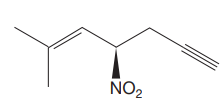
The IUPAC name for the above molecule, without considering the stereochemistry, would be
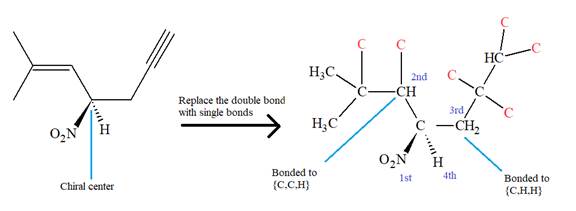
The second and third priority substituents are decided by the set of atoms one bond away from the respective points of attachment. The set for the substituent, which is located on the right, is
The configuration at the chiral center of the molecule is designated as above.
(d)
Interpretation:
The R or S configuration of the chiral center in the given molecule is to be designated.
Concept introduction:
When assigning priorities to substituents, the atom having the greater atomic number has the higher priority. In case of comparison between isotopes, the one having the greater atomic mass gets the higher priority. Substituents with double/triple bonds are treated differently from the substituents having only single bonds. An atom that is doubly bonded to another atom is treated as having two single bonds to the atom – one real (shown in black) and one imaginary (shown in red). An atom that is triply bonded to another atom is treated as having three single bonds to the atom – one real (shown in black) and two imaginary (shown in red).
When the fourth priority substituent is pointing away (it is attached by a dash bond) and the first, second, and third priority substituents are arranged clockwise, the configuration is R.
When the fourth priority substituent is pointing away (it is attached by a dash bond) and the first, second, and third priority substituents are arranged counterclockwise, the configuration is S.
If the fourth priority substituent is attached by a wedge bond, then the clockwise or counterclockwise arrangement of the first, second, and third priority substituents is determined, and that arrangement is reversed before assigning R or S.
If the fourth priority substituent is in the plane of the page, then it is switched with the substituent that points away. Then the clockwise or counterclockwise arrangement of the first, second, and third priority substituents is determined, and that arrangement is reversed before assigning R or S.
Answer to Problem C.10P
The configuration of the chiral carbon atom in the given molecule is designated as R.
Explanation of Solution
The given molecule is
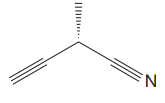
The molecule contains two triple bonds. There is one chiral center in this molecule, and the substituents attached to it are
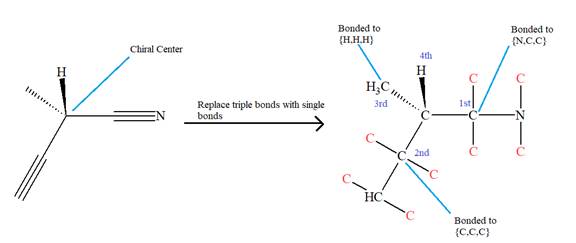
The top three-priorities are decided by the set of atoms one bond away from the respective points of attachment.
The set for the substituent, which is located on the right, is
Given that these substituents are arranged in the counterclockwise manner, but since the fourth-priority substituent is attached by a wedge bond, the arrangement is considered as reverse, that is, clockwise, and the configuration at the chiral center is R. Thus, the configuration at the chiral center for the molecule is R.
The configuration at the chiral center of the molecule is designated as above.
(e)
Interpretation:
The R or S configuration of the chiral center in the given molecule is to be designated.
Concept introduction:
When assigning priorities to substituents, the atom having the greater atomic number has the higher priority. In case of comparison between isotopes, the one having the greater atomic mass gets the higher priority. Substituents with double/triple bonds are treated differently from the substituents having only single bonds. An atom that is doubly bonded to another atom is treated as having two single bonds to the atom – one real (shown in black) and one imaginary (shown in red). An atom that is triply bonded to another atom is treated as having three single bonds to the atom – one real (shown in black) and two imaginary (shown in red).
When the fourth priority substituent is pointing away (it is attached by a dash bond) and the first, second, and third priority substituents are arranged clockwise, the configuration is R.
When the fourth priority substituent is pointing away (it is attached by a dash bond) and the first, second, and third priority substituents are arranged counterclockwise, the configuration is S.
If the fourth priority substituent is attached by a wedge bond, then the clockwise or counterclockwise arrangement of the first, second, and third priority substituents is determined, and that arrangement is reversed before assigning R or S.
If the fourth priority substituent is in the plane of the page, then it is switched with the substituent that points away. Then the clockwise or counterclockwise arrangement of the first, second, and third priority substituents is determined, and that arrangement is reversed before assigning R or S.
Answer to Problem C.10P
The configuration of the chiral carbon atom in the given molecule is designated as R.
Explanation of Solution
The given molecule is
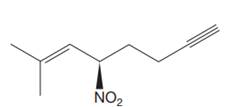
The molecule contains one double bond and one triple bond. There is one chiral center in this molecule, and the substituents attached to it are

The second and third priority substituents are decided by the set of atoms one bond away from the respective points of attachment. The set for the substituent, which is located on the right, is
The configuration at the chiral center of the molecule is designated as above.
Want to see more full solutions like this?
Chapter C Solutions
EBK GET READY FOR ORGANIC CHEMISTRY
- Epoxides can be opened in aqueous acid or aqueous base to produce diols (molecules with two OH groups). In this question, you'll explore the mechanism of epoxide opening in aqueous acid. 2nd attempt Be sure to show all four bonds at stereocenters using hash and wedge lines. 0 0 Draw curved arrows to show how the epoxide reacts with hydronium ion. 100 +1: 1st attempt Feedback Be sure to show all four bonds at stereocenters using hash and wedge lines. See Periodic Table See Hint H A 5 F F Hr See Periodic Table See Hintarrow_forward03 Question (1 point) For the reaction below, draw both of the major organic products. Be sure to consider stereochemistry. > 1. CH₂CH₂MgBr 2. H₂O 3rd attempt Draw all four bonds at chiral centers. Draw all stereoisomers formed. Draw the structures here. e 130 AN H See Periodic Table See Hint P C Brarrow_forwardYou may wish to address the following issues in your response if they are pertinent to the reaction(s) you propose to employ:1) Chemoselectivity (why this functional group and not another?) 2) Regioselectivity (why here and not there?) 3) Stereoselectivity (why this stereoisomer?) 4) Changes in oxidation state. Please make it in detail and draw it out too in what step what happens. Thank you for helping me!arrow_forward
- 1) Chemoselectivity (why this functional group and not another?) 2) Regioselectivity (why here and not there?) 3) Stereoselectivity (why this stereoisomer?) 4) Changes in oxidation state. Everything in detail and draw out and write it.arrow_forwardCalculating the pH at equivalence of a titration 3/5 Izabella A chemist titrates 120.0 mL of a 0.7191M dimethylamine ((CH3)2NH) solution with 0.5501 M HBr solution at 25 °C. Calculate the pH at equivalence. The pk of dimethylamine is 3.27. Round your answer to 2 decimal places. Note for advanced students: you may assume the total volume of the solution equals the initial volume plus the volume of HBr solution added. pH = ☐ ✓ 18 Ar Boarrow_forwardAlcohols can be synthesized using an acid-catalyzed hydration of an alkene. An alkene is combined with aqueous acid (e.. sulfuric acid in water). The reaction mechanism typically involves a carbocation intermediate. > 3rd attempt 3343 10 8 Draw arrows to show the reaction between the alkene and hydronium ion. that 2nd attempt Feedback 1st attempt تعمال Ju See Periodic Table See Hint F D Ju See Periodic Table See Hintarrow_forward
- Draw the simplified curved arrow mechanism for the reaction of acetone and CHgLi to give the major product. 4th attempt Π Draw the simplified curved arrow mechanism T 3rd attempt Feedback Ju See Periodic Table See Hint H -H H -I H F See Periodic Table See Hintarrow_forwardSelect the correct reagent to accomplish the first step of this reaction. Then draw a mechanism on the Grignard reagent using curved arrow notation to show how it is converted to the final product. 4th attempt Part 1 (0.5 point) Select the correct reagent to accomplish the first step of this reaction. Choose one: OA Mg in ethanol (EtOH) OB. 2 Li in THF O C. Li in THF D. Mg in THF O E Mg in H2O Part 2 (0.5 point) Br Part 1 Bri Mg CH B CH, 1 Draw intermediate here, but no arrows. © TE See Periodic Table See Hint See Hint ין Harrow_forwardSelect the product for the following reaction. HO HO PCC OH ○ OH O HO ○ HO HO HOarrow_forward
- 5:45 Х Select the final product for the following reaction sequence. O O 1. Mg. ether 2.D.Oarrow_forwardBased on the chart Two similarities between the molecule with alpha glycosidic linkages. Two similarities between the molecules with beta glycosidtic linkages. Two differences between the alpha and beta glycosidic linkages.arrow_forwardplease help fill in the tablearrow_forward
 Organic Chemistry: A Guided InquiryChemistryISBN:9780618974122Author:Andrei StraumanisPublisher:Cengage Learning
Organic Chemistry: A Guided InquiryChemistryISBN:9780618974122Author:Andrei StraumanisPublisher:Cengage Learning
